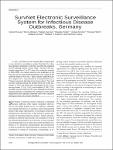SurvNet Electronic Surveillance System for Infectious Disease Outbreaks, Germany.
Krause, Gérard
Altmann, Doris
Faensen, Daniel
Porten, Klaudia
Benzler, Justus
Pfoch, Thomas
Ammon, Andrea
Kramer, Michael H.
Claus, Hermann
In 2001, the Robert Koch Institute (RKI) implemented a new electronic surveillance system (SurvNet) for infectious disease outbreaks in Germany. SurvNet has captured 30,578 outbreak reports in 2001-2005. The size of the outbreaks ranged from 2 to 527 cases. For outbreaks reported in 2002-2005, the median duration from notification of the first case to the local health department until receipt of the outbreak report at RKI was 7 days. Median outbreak duration ranged from 1 day (caused by Campylobacter) up to 73 days (caused by Mycobacterium tuberculosis). The most common settings among the 10,008 entries for 9,946 outbreaks in 2004 and 2005 were households (5,262; 53%), nursing homes (1,218; 12%), and hospitals (1,248; 12%). SurvNet may be a useful tool for other outbreak surveillance systems because it minimizes the workload of local health departments and captures outbreaks even when causative pathogens have not yet been identified.
No license information

